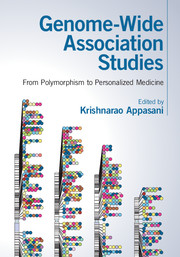Book contents
- Frontmatter
- Dedication
- Contents
- List of contributors
- Forewords
- Preface
- List of abbreviations
- Part I Genome-wide association studies
- Part II Genome-wide studies in disease biology
- Part III Single nucleotide polymorphisms, copy number variants, haplotypes and eQTLs
- 10 Finding SNPs that affect microRNA regulation in disease-associated genomic regions
- 11 From linkage to complex associations: the role of GABRA2 as a risk factor for alcohol use
- 12 Copy number variation in monozygous twins
- 13 Haplotypes of CpG-related SNPs and associations with DNA methylation patterns
- 14 eQTL mapping
- Part IV Next-generation sequencing technology and pharmaco-genomics
- Part V Population genetics and personalized medicine
- Index
- Plate section
- References
12 - Copy number variation in monozygous twins
from Part III - Single nucleotide polymorphisms, copy number variants, haplotypes and eQTLs
Published online by Cambridge University Press: 18 December 2015
- Frontmatter
- Dedication
- Contents
- List of contributors
- Forewords
- Preface
- List of abbreviations
- Part I Genome-wide association studies
- Part II Genome-wide studies in disease biology
- Part III Single nucleotide polymorphisms, copy number variants, haplotypes and eQTLs
- 10 Finding SNPs that affect microRNA regulation in disease-associated genomic regions
- 11 From linkage to complex associations: the role of GABRA2 as a risk factor for alcohol use
- 12 Copy number variation in monozygous twins
- 13 Haplotypes of CpG-related SNPs and associations with DNA methylation patterns
- 14 eQTL mapping
- Part IV Next-generation sequencing technology and pharmaco-genomics
- Part V Population genetics and personalized medicine
- Index
- Plate section
- References
Summary
Introduction
Microarray technology in GWAS and copy number variations
Genome-wide association studies (GWAS) are used to associate human disease and traits with a certain chromosomal locus or loci. This is done by whole-genome genotyping of many cases and controls using so-called tag-SNP probes containing a relative common SNP associated with a region in linkage disequilibrium (LD). If a certain tag-SNP has a statistically significant higher frequency in cases compared to controls, the studied trait or disease is said to be associated with that specific locus. This method has proven to be successful in many occasions (Hindorff et al., 2009; Manolio 2013) and has increased our knowledge of disease etiology and human development significantly. Genotyping has mainly been done using microarrays with up to several million allele-specific oligo-probes. These microarrays contain information on the relative amount of DNA at a given locus. Using both genotype and quantitative information, these SNP-based GWAS studies can be extended to include DNA gains or losses. These segmental variations in DNA copy number can arise de novo or be inherited in a Mendelian matter. Many of the characteristics of other types of genomic variation are shared: they can be ancestry-specific, are driven by selection pressure, and can influence the expression of genes by altering their copy number or affecting gene regulatory regions (Zhang et al., 2009; Schlattl et al., 2011). Losses can result in haploinsufficiency of one or several genes or truncated proteins, while gains can increase gene expression or can also lead to altered protein structure, reduced protein levels or function.
Copy number variation; common, rare, and de novo
Many gains and losses are rather common and most likely represent the normal population variance (Zhang et al., 2009; Stankiewicz and Lupski, 2010). These recurrent DNA variations have an allele frequency of over 1% and are called common copy number polymorphisms (CNPs). CNPs account for a significant proportion of the healthy human genome (Iafrate et al., 2004; Sebat et al., 2004). They often arise after non-allelic homologous recombination of misaligned DNA segments due to the presence of low copy repeats (Stankiewicz and Lupski, 2010). In general, common copy number variations (CNVs) are not associated with severe congenital anomalies, but could influence human traits such as height (van Duyvenvoorde et al., 2014), or aging (Iakoubov et al., 2013).
- Type
- Chapter
- Information
- Genome-Wide Association StudiesFrom Polymorphism to Personalized Medicine, pp. 168 - 192Publisher: Cambridge University PressPrint publication year: 2016



